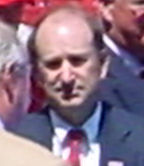List of St. Louis Cardinals owners and executives
In 1882, the St. Louis Brown Stockings were purchased by Chris von der Ahe, a German immigrant who became a grocer and saloon owner.
[1] After the Browns profited $25,000 from playing a season's worth of informal contests, Von der Ahe bought out the team's remaining stockholders for $1,800.
He was willing to charge lower admission rates, encouraged play on Sundays, and sold beer at the stadium, a practice that the National League prohibited at the time.
Charlie O. Finley, Larry McPhail, and Bill Veeck eventually employed sideshow attractions such as the "stadium club" and the shoot-the-chute.
Breadon convinced cross-town American League rival St. Louis Browns owner Phil Ball to allow the Cardinals to move into Sportsman's Park.
This allowed him to sell the dilapidated Robison Field property for a total of $275,000 to the city and a trolley company, clear the team's debts, and, with Rickey's oversight, establish an official, contractually-linked minor league farm system, the predecessor of today's minor league system.
[8] In 1947, Breadon sold the Cardinals to Fred Saigh and Robert Hannegan for $3 million, at the time the largest transaction in baseball history.
[7][9] At the end of the 1947 baseball season, Saigh got wind that longtime Cardinals owner Sam Breadon wanted to sell.
The Cardinals had long since surpassed the Browns as the city's most popular team, and Breadon wanted to build a park of his own.
Hannegan was a prominent St. Louis businessman, former United States Postmaster General, and confidante of President Harry Truman.
The Cardinals, though then just one year removed from their ninth National League pennant and sixth World Series championship since 1926, had begun to decay as an organization.
Five years before, Breadon had forced out legendary general manager Branch Rickey, who had quickly resurfaced with the Brooklyn Dodgers.
[14] He served five months at the federal penitentiary in Terre Haute, Indiana, leaving in November 1953 when he was given parole for good behavior.
[15] However, just before he was due to reach a final agreement with the Houston group, Saigh sold the Cardinals to Anheuser-Busch, the St. Louis-based brewery.
[17] As chairman, president or CEO of the Cardinals from the time the club was purchased by the brewery in 1953 until his death, Busch oversaw a team that won six National League pennants (1964, 1967, 1968, 1982, 1985, and 1987) and three World Series (1964, 1967 and 1982).
[19] Former Cardinal catcher and third baseman Joe Torre replaced Whitey Herzog as manager late in the 1990 season after he unexpectedly resigned.
[20][21] Despite an in-season trade to the Oakland A's that season, outfielder Willie McGee attained the requisite number of plate appearances to win his second NL batting title with the Cardinals at .335, making him the only player to win a batting title and end the same season in the other Major League.
[25] As with other periods of the Cardinals' transaction history, doubt loomed as to whether the purchaser would keep the team in St. Louis, due to the city's status as a "small market," which appear to handicap a club's competitiveness.
To allow their purchase of the Reds in 2005, the rest of the group bought out Castellini's and the Williams brothers' shares, totaling an estimated 13%.
Branch Rickey was the Cardinals' first official GM – however, his role initially called for him to function more as a business manager – as he pioneered certain functions attributed to the contemporary GM, such as developing the forerunner of the minor league farm system that all Major League Baseball franchises use today.
Rickey, William Walsingham Jr., Musial, Joe McDonald, Walt Jocketty and Mozeliak each won at least one World Series as Cardinals GM.



